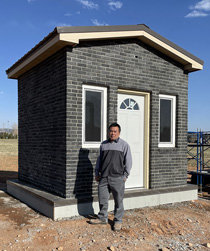
A New Future for Coal
October 10, 2022

Associate Professor Kam Ng stands in front of the completed coal char-brick house
near the UW High Bay Research Facility. (Courtesy image)
UW researchers show off numerous coal-derived building materials in a demonstration house.
By Christine Reed and Micaela Myers
Imagine a house built from coal-derived materials. It’s not an updated tale of the three little pigs, but instead it’s reality at the University of Wyoming — thanks to an innovative student team, a professor and the folks at the School of Energy Resources’ Center for Carbon Capture and Conversion.
Early results show that coal-derived char bricks perform better than traditional clay bricks in many ways — they are lighter, stronger, more fire resistant and more environmentally friendly, and economically they are less expensive to produce. These are exciting features at a time when the costs of building materials are through the roof. A demonstration char-brick house was completed this past spring — along with a second house made of traditional materials so the two can be compared. It’s the first char-brick house to be built in the U.S. After testing, it can be moved as an exhibition.
“The goal of the project is to see how the coal-derived building materials, especially char bricks, stand up to different environmental conditions and compare to conventional building materials that are currently used in the market,” says ChooiKim Lau, the Department of Civil and Architectural Engineering and Construction Management graduate student leading the project. “Our team will evaluate performance characteristics — such as the mechanical integrity, thermal resistance, light weight, fire resistance, toxicity and electromagnetic radiation tolerance — with comparative durability, noise resistance, moisture absorption and weathering.” Lau is originally from Alor Setar, Malaysia, and now a resident of Laramie, Wyo. and a U.S. citizen.
Lau is working alongside undergraduate students Noah Scott and Jonathan Scott, both from Cheyenne, Wyo. They work under the direction of Kam Ng, an associate professor in the Department of Civil and Architectural Engineering and Construction Management within the College of Engineering and Physical Sciences.
The work is associated with Center for Carbon Capture and Conversion, directed by Richard Horner. The center is dedicated to discovering and advancing new uses coal. In addition to char bricks, researchers at UW have developed a multitude of coal-derived building materials including mortar, plaster, flooring materials, roofing materials, insulation materials and structural units to supplement concrete, timber and steel.
“Our objective is to build a house with the maximum amount of coal in it,” Horner says. “All of the materials that are used in building today we believe we can make from Wyoming coal.”
In the summer of 2021, the team manufactured over 4,000 char bricks in the span of 30 days using basic tools and equipment.
“We made them by hand in a zero-waste method and cured them outside using little energy input — only the natural sun and wind of Laramie,” Lau says. “The porosity and thermal properties of the coal char bricks are such that they have the ability to absorb moisture from inside buildings on humid days and release moisture on dry days, which means that the building is consuming less energy.”
Horner says: “Our objective in the School of Energy Resources is not just to do research but to commercialize these efforts and create new jobs and industries in Wyoming. Currently, coal is a main source of income for the state, so efforts to keep mines operating will allow us to have a continued revenue stream for our state to invest in education, infrastructure, medical care, emergency services and the overall well-being of Wyoming citizens.”
It will also play a major role in growing Wyoming and creating diversification opportunities in the manufacturing industry, he says.
The team will monitor the performance of coal-derived versus conventional building materials for one year, which will provide a good baseline. The data and results will then be shared with interested industry partners, with the intent of taking the technology to market.
“We hope that our research will highlight the competitive advantages of our coal-derived char bricks to the construction industry and increase the products’ marketability, usage and consumption, further advancing to the next stage of commercialization and production,” Ng says.
“I’m so proud of this project,” Lau adds. “When I’m making these bricks, I feel like I’m creating jobs for the future.”
